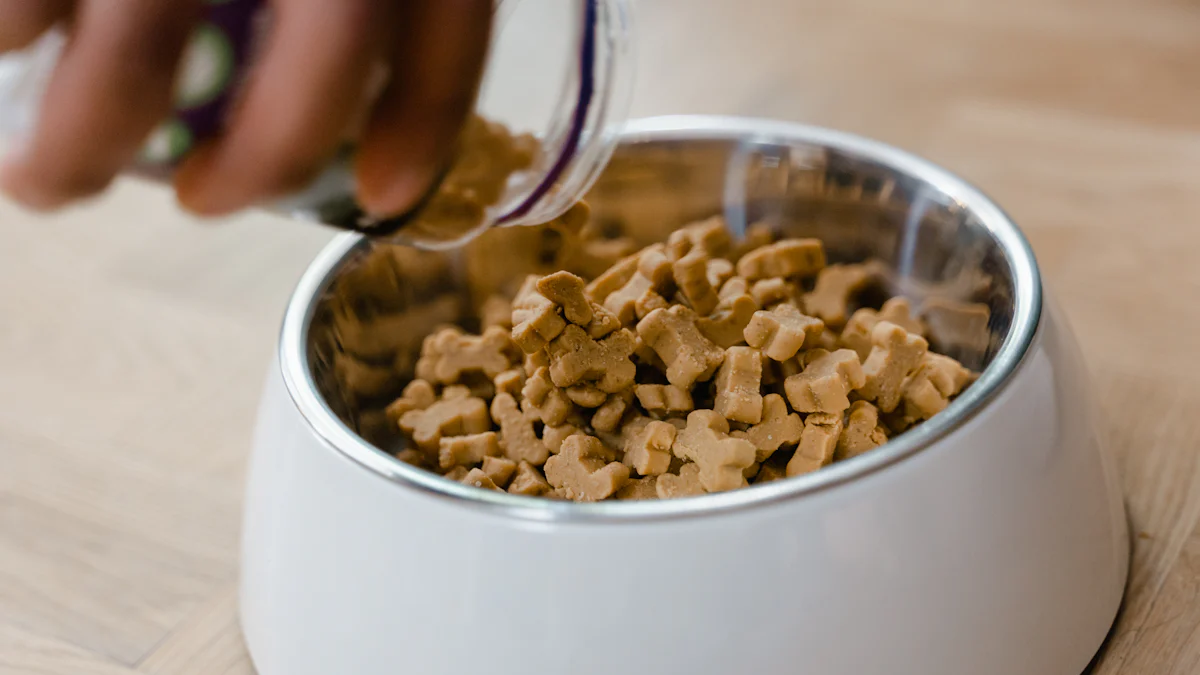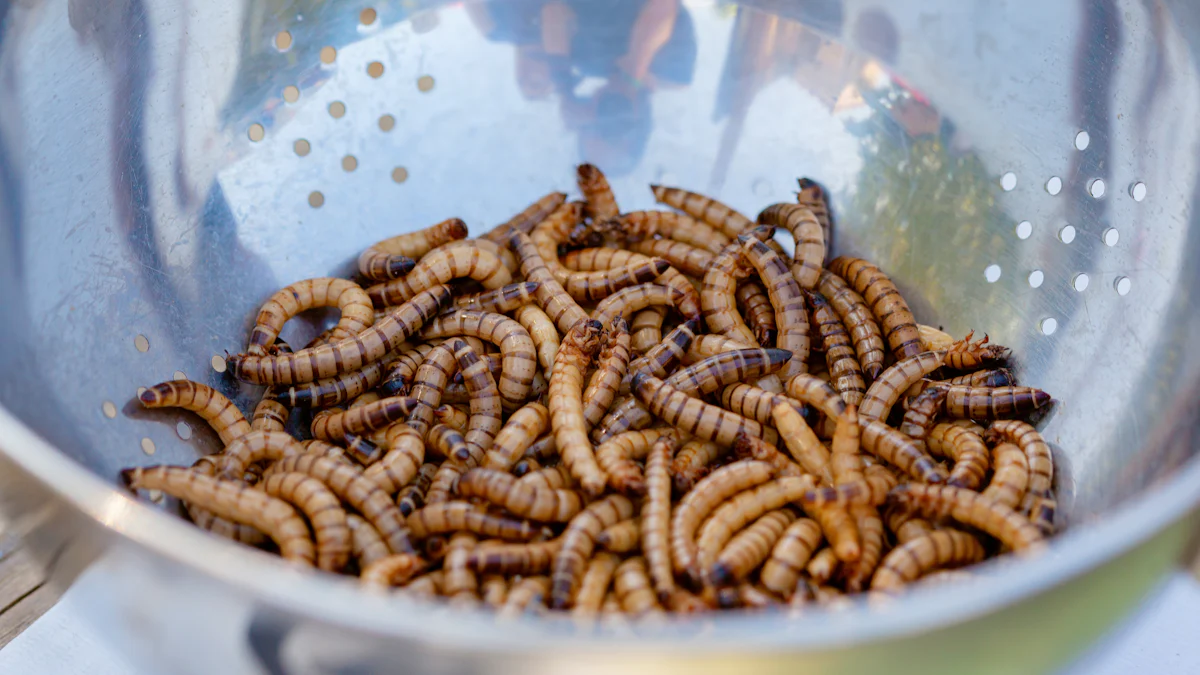
Have you ever thought about how mealworms could transform pet food and feed? These tiny insects pack a punch when it comes to nutrition. With 50 grams of protein per 100 grams, they’re a powerhouse for energy and growth. Plus, they’re easy to find in bulk, often sold with bran or oatmeal for food.
Mealworms don’t just nourish pets—they help the planet too. They use less water and space than traditional feed sources, making them an eco-friendly choice.
Whether you’re feeding reptiles, birds, or livestock, mealworms as feed and pet food are practical, sustainable, and full of benefits.
Key Takeaways
- Mealworms are full of nutrients, with 50 grams of protein in 100 grams. They are great for pets and farm animals.
- They are good for the environment, needing less land and water than regular feed. They also help lower harmful gas emissions.
- Mealworms can be given to many animals like reptiles, birds, fish, and small mammals. They help animals stay healthy and grow.
Nutritional Benefits of Mealworms as Feed and Pet Food

High Protein and Fat Content for Energy and Growth
Mealworms are like little energy boosters for animals. Did you know they pack around 50 grams of protein per 100 grams? That’s a lot! Protein is essential for muscle growth and repair, which is why mealworms are such a great choice for pets and livestock. They also contain a good amount of fat—anywhere from 13.4% to 33.4%, depending on their diet. This fat provides energy, especially for active animals.
Here’s a quick comparison to show how they stack up:
| Feed Option | Protein (g/100g) | Fat Content (%) |
|---|---|---|
| Mealworms | 50 | 13.4 – 33.4 |
| Conventional Meat | Higher than mealworms | Varies |
Mealworms are not just nutritious; they’re adaptable too. Their diet can influence their fat content, making them a flexible option for different feeding needs.
Rich in Essential Amino Acids, Vitamins, and Minerals
Mealworms are like a multivitamin for animals. They’re loaded with essential amino acids, which are the building blocks of protein. These amino acids help animals grow strong and stay healthy. Plus, mealworms are rich in vitamins like B12 and B2, which help convert food into energy. They also contain minerals like zinc, iron, and magnesium, which support immune function and bone health.
Here’s what’s inside a mealworm:
| Nutrient Type | Nutrients Found |
|---|---|
| Amino Acids | Essential amino acids |
| Vitamins | E, B12, B3, B2, B5, H |
| Minerals | Copper, Iron, Zinc, Magnesium, Potassium, Phosphorus |
With all these nutrients, mealworms as feed and pet food are a fantastic way to keep animals healthy and thriving.
Excellent Digestibility for Pets and Livestock
One of the best things about mealworms is how easy they are to digest. Their protein digestibility rate is over 90% for most amino acids. That means animals can absorb and use the nutrients efficiently. Studies even show that mealworms can replace traditional feed ingredients like fishmeal or soymeal without compromising nutrition.
For example, when weaning pigs were fed diets with up to 6% mealworm, their growth performance improved. This shows how mealworms can support both health and growth in animals. Whether you’re feeding reptiles, birds, or livestock, mealworms are a highly digestible and nutritious option.
Sustainability of Mealworms as Feed and Pet Food
Minimal Environmental Impact Compared to Traditional Feed
When I think about the environmental impact of traditional feed sources like soy or fishmeal, it’s clear that mealworms are a game-changer. They produce far fewer greenhouse gases compared to livestock like cattle and pigs. For example, mealworms emit much lower levels of ammonia, CO2, and methane. This makes them a fantastic option for reducing the carbon footprint of pet food and feed.
Mealworms also need less land to produce the same amount of protein as traditional livestock. That’s a big deal, especially in areas where land is scarce. Plus, their feed conversion rates are incredibly efficient. They use nitrogen more effectively than cattle, which helps minimize environmental harm.
Efficient Use of Resources in Mealworm Farming
Mealworm farming is surprisingly resource-friendly. Producing 1 kilogram of mealworms requires much less land and water than raising livestock. They’re also 500 times more efficient than soy when it comes to water use. That’s huge, especially in regions facing water shortages.
What’s even cooler is how mealworms convert food into body weight. Their conversion ratio is 2:1, while cattle need an 8:1 ratio. This means mealworms grow faster and use fewer resources. Farmers have even adopted innovations like water gel crystals for moisture and mesh trays to protect eggs. These methods make farming more efficient and sustainable.
| Innovation | Description | Impact on Resource Efficiency |
|---|---|---|
| Automation | Utilizes existing equipment from other industries to automate mealworm farming processes. | Reduces labor costs and increases efficiency. |
| Optimal Humidity Levels | Maintaining humidity levels between 70-80% significantly improves mealworm growth and survival. | Enhances growth rates and reduces mortality. |
| Improved Feed Types | Switching from wheat bran to rice bran doubles growth rates and produces gluten-free protein. | Increases protein yield per kilogram of feed. |
Role in Reducing Food Waste and Supporting Circular Economy
Mealworms are like little recycling machines. They can turn organic waste into nutritious feed and food products. I love how this supports a circular economy. For instance, mealworms can eat agricultural by-products, which reduces food waste. Their frass (waste) can even be used as fertilizer, putting nutrients back into the soil.
Mealworms don’t just reduce waste—they create value. By transforming organic residues into protein, they help make food production systems more sustainable.
Some farms already feed mealworms with food waste, which lowers costs and boosts sustainability. It’s amazing how both the larvae and their by-products contribute to agriculture.
| Evidence Description | Key Points |
|---|---|
| Use of Agri-Food Waste | Mealworms can be fed agricultural food waste, enhancing sustainability in farming. |
| Nutritional Benefits | Waste materials provide proteins, carbohydrates, and vitamins essential for mealworm growth. |
| Economic Sustainability | Utilizing food waste reduces costs and supports sustainable production practices. |
Mealworms as feed and pet food aren’t just good for animals—they’re good for the planet too.
Practical Applications of Mealworms as Feed and Pet Food
Suitable for Reptiles, Birds, Fish, and Small Mammals
Mealworms are a hit with so many animals! I’ve seen reptiles like bearded dragons and turtles go crazy for them. They’re packed with protein, which helps reptiles grow and stay active. Birds love them too. Wild birds like orioles and wrens enjoy mealworms as a treat, especially during nesting season when they need extra energy.
Fish also benefit from mealworms. Carnivorous species like goldfish and guppies thrive on their protein-rich diet. Plus, mealworms help enhance their vibrant colors. Small mammals, like hamsters and hedgehogs, enjoy mealworms as a snack. They’re great for muscle maintenance and overall health. Chickens, on the other hand, use mealworms to grow feathers and lay eggs.
Mealworms are versatile and meet the nutritional needs of many animals. They’re like a universal snack for pets and wildlife!
Use in Livestock Feed, Including Poultry and Aquaculture
Mealworms are making waves in livestock feed. Farmers use them as a sustainable alternative to soy or fishmeal. Poultry love them, and studies show that adding mealworms to their diet improves growth and egg production. I’ve read that even aquaculture benefits. Fish like tilapia and rainbow trout grow better when mealworms replace up to 25% of their feed.
What’s cool is that mealworms can be used live or processed into meals and oils. They’re easy to mix with other feed sources and require less processing than soy. This makes them a cost-effective and eco-friendly option for farmers.
Incorporation into Commercial Pet Food for Dogs and Cats
Mealworms are popping up in pet food too. They’re rich in essential nutrients like amino acids, fats, and vitamins, making them a premium ingredient. Some brands mix mealworms into kibble or soft food to add flavor and texture. I’ve even seen them used as treats for dogs and cats.
Mealworms are also processed into pellets or wet food through safe methods like extrusion and heat treatment. Research shows that mealworm protein is as digestible as milk protein, which is great for muscle production. It’s exciting to see how mealworms as feed and pet food are becoming a staple in the pet industry.
Tips for Raising or Sourcing Mealworms
How to Raise Mealworms at Home with Minimal Effort
Raising mealworms at home is easier than you might think. I’ve done it myself, and it’s a low-maintenance way to have a steady supply. Here’s how you can get started:
- Food/Substrate/Bedding: Use wheat bran, rolled oats, or cornmeal as bedding and food. Layer it about 2-3 inches deep.
- Supplements: Add wheat germ or brewer’s yeast to boost nutrition.
- Container: Pick a shallow plastic container with a large surface area. Make sure it’s at least 1 inch deep to keep the mealworms from escaping.
- Ventilation and Cover: Ensure proper airflow to prevent mold. Cover the container to keep pests out.
- Temperature: Keep the temperature between 77-81ºF for the best growth.
- Moisture and Humidity: Provide moisture, like slices of carrots or potatoes, and aim for 70% humidity.
You might face some challenges, like pests or mold. Freezing the bedding before use can kill mites. Regular cleaning and good ventilation also help. If the culture gets too dry, mealworms might start eating each other. Keeping it moist prevents this.
Where to Buy Mealworms Safely and Responsibly
If raising mealworms isn’t your thing, buying them is a great option. I always recommend sourcing them from reputable suppliers. Look for sellers who follow strict quality control measures. Certified suppliers test for contaminants and pathogens, ensuring the mealworms are safe for your pets or livestock.
When buying, check if the supplier complies with food safety standards. A clean environment and regular testing are signs of a reliable source. Some suppliers even offer mealworms in bulk, often packed with bran or oatmeal for food. This makes them convenient and ready to use.
Ensuring Quality and Safety in Mealworm Feed
Quality matters when using mealworms as feed. Low-quality mealworms can pose risks like allergies or contamination. For example, mealworms might accumulate heavy metals if their feed isn’t monitored. To avoid this, I always ensure the feed substrate is tested for microbiological quality.
Suppliers should follow strict rearing protocols and use innovative analysis technologies to maintain safety. Frequent checks during processing help ensure compliance with agri-food legislation. These steps guarantee that the mealworms are nutritious and safe for your animals.
Tip: Always store mealworms in a cool, dry place to maintain their quality.
Mealworms are a game-changer for pet food and feed. They’re packed with protein, essential nutrients, and healthy fats, making them a top-notch choice for animals. Plus, they’re eco-friendly. They use less land and water, produce fewer emissions, and even help reduce food waste.
I love how versatile they are. You can use them for reptiles, birds, fish, and even livestock. They’re easy to raise or buy, and they fit right into sustainable farming practices. Whether you’re a pet owner or a farmer, mealworms offer a practical way to support your animals while protecting the planet.
Why not give mealworms a try? They’re nutritious, sustainable, and a smart choice for a better future.
FAQ
What are mealworms used for?
Mealworms are packed with protein, making them great for pet food and feed. They’re also popular as fishing bait and even used in sustainable farming practices.
Where can I buy mealworms?
You can find mealworms in bulk at pet stores or online. They’re usually sold in containers with bran or oatmeal to keep them fresh.
Are mealworms safe for pets?
Yes! Mealworms are safe and nutritious for most pets. Just make sure they come from a reliable source to ensure quality and safety.


